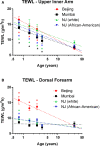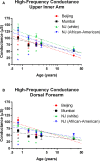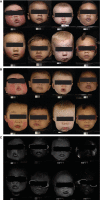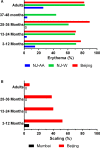Water-Holding and Transport Properties of Skin Stratum Corneum of Infants and Toddlers Are Different from Those of Adults: Studies in Three Geographical Regions and Four Ethnic Groups
- PMID: 26860213
- PMCID: PMC5067706
- DOI: 10.1111/pde.12798
Water-Holding and Transport Properties of Skin Stratum Corneum of Infants and Toddlers Are Different from Those of Adults: Studies in Three Geographical Regions and Four Ethnic Groups
Abstract
Background/objective: Epidermal structure, function, and composition are different in white infants and adults. We investigated whether ethnicity and location contribute to differences in functional and clinical measurements of skin barrier function during the first years of life and in adults.
Methods: Children (n = 397, ages 3-49 mos) and women (n = 117, mean age 31 yrs) were enrolled at independent centers in Beijing, China (ethnic Chinese), Skillman, New Jersey (white, African American), and Mumbai, India (ethnic South Asian). Water barrier properties of the stratum corneum were assessed using high-frequency conductance and transepidermal water loss (TEWL) on the dorsal forearm and upper inner arm. Digital imaging was used to evaluate facial erythema and scaling.
Results: Despite differences in local climate, TEWL was similar in adults. In children, conductance and TEWL decreased monotonically from age 3 months to 4 years. In children from Beijing, TEWL values were higher in both arm locations than in children in Mumbai and Skillman. No significant differences were observed in TEWL or conductance between the white and African American groups.
Conclusion: In general, TEWL and conductance were greater on the upper inner arm than the dorsal forearm. Erythema and scaling were observed most often in subjects from Beijing and most infrequently in subjects from Mumbai. Stratum corneum water barrier properties were different in children and adults. Although there may be differences in these properties between ethnic groups in childhood, TEWL values were similar in adults across the three geographic locations and four ethnicities.
© 2016 Johnson & Johnson Consumer Companies, Inc. Pediatric Dermatology published by Wiley Periodicals, Inc.
Figures




References
-
- Nikolovski J, Stamatas GN, Kollias N et al. Barrier function and water‐holding and transport properties of infant stratum corneum are different from adult and continue to develop through the first year of life. J Invest Dermatol 2008;128:1728–1736. - PubMed
-
- Stamatas GN, Nikolovski J, Luedtke MA et al. Infant skin microstructure assessed in vivo differs from adult skin in organization and at the cellular level. Pediatr Dermatol 2010;27:125–131. - PubMed
-
- Stamatas GN, Nikolovski J, Mack MC et al. Infant skin physiology and development during the first years of life: a review of recent findings based on in vivo studies. Int J Cosmet Sci 2011;33:17–24. - PubMed
-
- Rawlings AV. Ethnic skin types: are there differences in skin structure and function? Int J Cosmet Sci 2006;28:79–93. - PubMed
-
- Chiou YB, Blume‐Peytavi U. Stratum corneum maturation. A review of neonatal skin function. Skin Pharmacol Physiol 2004;17:57–66. - PubMed
Publication types
MeSH terms
LinkOut - more resources
Full Text Sources
Other Literature Sources
Medical

